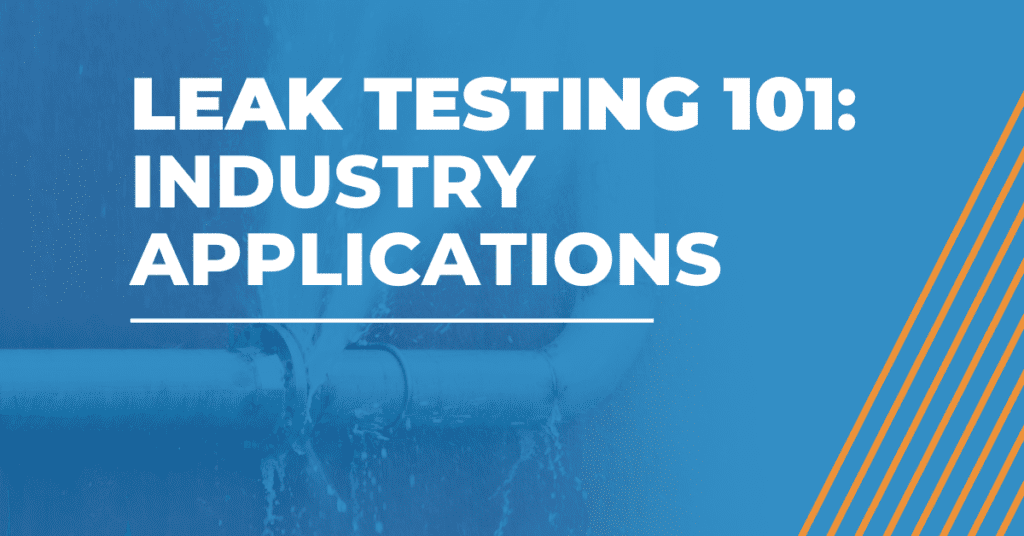
Leak Testing 101: Industry Applications
Leak Testing Overview
Leak testing is a common procedure that manufacturers use to test whether or not a product is functioning at its intended leak rate. Leaks occur when the assembly of the part or system has failed and shows leakage during the test time. To calculate a leak, the leak-testing device must compute the rate at which pressure is exiting the system during testing, known as the allowable leak rate. With standard leak rates set, each part can be assessed to see if it’s ready to move to inventory.
Many would be surprised at the vast array of applications request a leak test. Leak testing can be applied to assemblies in nearly every industry including medical, automotive, aerospace, power generation, household appliances, electronic, foundry, gas, mechanical, oleodynamic, packaging, pneumatic and heating. The different types of leak testing include ultrasonic, helium, acoustic, halogen, fluorescent, vacuum decay, infrared, flame ionization, spot leak, hydrogen leak, residual, pressure decay and high voltage. In this blog, we review the most common industries and the applications that apply.
Medical Industry
Medical device manufacturers have extremely high quality standards to reduce risk. Leak testing in the medical industry is critically important. Blood filters, catheters, syringes, ventilator tubes and other devices must meet strict FDA criteria to be put on the market and sold. Both pressure decay and mass flow leak testing systems are widely used throughout the medical industry. Pressure decay testing can be conducted through positive internal pressurization or negative (vacuum) external pressurization.
Automotive Industry
Parts that need leak testing in the automotive assembly include air conditioning systems, fuel systems, powertrain oil circuits, powertrain water circuits, engine water circuits and cooling circuit e-battery.
Automotive manufacturing needs test systems that can adapt to the ever-changing landscape and guidelines. Testing hoses, gaskets, valves, radiators, batteries and other components and assemblies to ensure proper functioning is industry standard. The data collected during these tests play a crucial role in the manufacturing process and assurance of safety. Air and gas leak testing are the most widely used and accepted methods for automotive.
Aerospace Industry
Ensuring safe flights means making sure that every part that is put onto an aircraft has been tried and tested to perform its duties properly. The aerospace industry has a wide variety of ways in which it uses leak testing. Helium and hydrogen testing can usually be seen in large applications like fuel tanks. Smaller components such as actuators use hydraulic testing. Determining the right method often depends on the part, the test measurement criteria and what flow rate and pressure is required.
Power Generation Industry
The vast majority of power plants in the United States are fueled by coal, nuclear materials, natural gas and oil. Turbines generating tons of energy require safe standards to ensure the safe convergence of energy. Helium leak testing is the most commonly used method in the power generation industry. Gasses are ionized and accelerated through a magnetic field in the mass spectrometer, which isolates gas molecules by mass. This separation allows for extremely small amounts of helium to be detected.
Another commonly used method is ultrasound detection to identify the source of a pressure or vacuum leak. As gas escapes from one higher-pressure system to the lower pressure, the molecules become excited. The amplitude of the sound at the source of the leak is dependent on the pressure differential, radiation pattern, humidity, temperature and the physical characteristics of the crack.
Household Appliances Industry
Think of all the systems and appliances found in a house: kettles, coffee makers, refrigerators, HVAC systems, washing machines, sprinklers, dishwashers, water heaters and more. They all require some form of a leak test. Helium leak testing is the most common form used in household appliances.
Electronics Industry
The electronics industry has grown more into leak testing in recent years. With technology growing and the demand for better, more durable products, manufacturers have to create competing products. Waterproof and sweat-proof products require prior leak detection. One must ensure that pressure equalization, as well as the function of speakers and microphones, can work properly while also allowing water to pass through. Water bubble and helium leak testing are two of the more common forms in the electronics industry.
Packaging Industry
Products that require leak testing in the packaging industry include bottles and containers for liquids and foodstuffs like oils, syrup, peanut butter, condiments, soup, vinegar, ground coffee and more. Pressure decay methods are the most common form of leak testing for these types of bottles and containers. By calculating the leak rate, manufacturers can ensure that each has passed and is ready for the market.
Applications: Finding the Best for You
Overall, testing for leaks ensures quality, increases productivity and improves profitability, especially automated leak testing. Depending on the scale and scope of your project, there are many different areas where leak testing is appropriate. You could try to identify the best method by collecting all the proper data and information, but going through these steps can be challenging and frustrating. Having someone who has in-depth knowledge of the industry and solution you need, such as a machine builder like Automated Machine Systems, can help combat these headaches. With a trusted partner and the right testing system in place, you can take your manufacturing to the next level.
